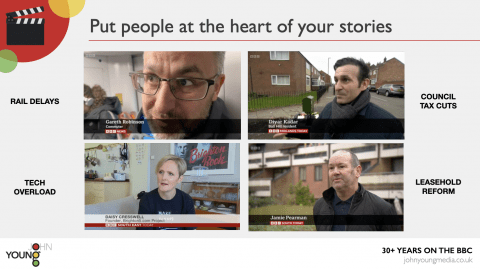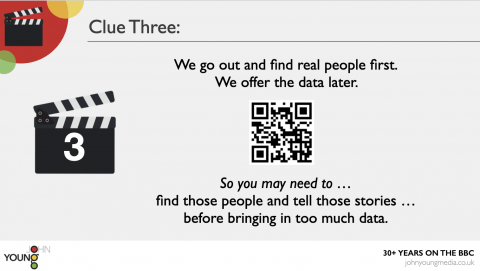“Good evening, and welcome to South East Today. Our Top Stories tonight …”
It’s a line I was privileged to utter many times over my twenty year career as one of the presenting team on the BBC’s nightly news programme covering the south-east of England.
But there’s one word in those two sentences that’s doing all the work.
“Stories”.
It’s why people watched, and (the statistics suggested) usually watched to the end.
If you apply the same principle to your own presentations, I reckon you’ll stand a much better chance of holding your own audience’s attention to the end.
Let’s be honest. They weren’t tuning in because they particularly wanted to see me or my co-presenter. Yes, TV presenters do build up a loyal base of people who enjoy their through-the-screen friendship, but it’s not the primary reason they tune in.
Audiences tune in because they want information, but they want it delivered in an engaging way. Stories are the vehicle for that.
Let me break down that principal — and then apply it to your world of business.
Many of the news stories I covered could be, put bluntly, complex and boring. But journalists take the view that they are paid, as journalists, to deal with that. It’s a journalist’s job to make boring things interesting.
Take a story about rail timetable changes, brought about to save money but dismaying some passengers. It’s boring, but it’s important. There are lots of facts in the story — schedules, rotas, budgets, policy, research.
Does the news reporter simply list those details, with charts and graphs on the screen?
No. The reporter’s first instinct is to find a real person caught up in it all, and (briefly) tell their story. And only once they’ve done that, they’ll perhaps put three or four key facts from those charts and graphs on the screen.
This slide from my latest workshop, How to Hold Your Audience’s Attention: Seven Clues from TV News! illustrates this.

A story about rail delays? We hear from a commuter, first. Then we get a few figures.
A story about council tax cuts? We hear from a local resident, first. Then we get a few statistics.
A story about tech overload in young people? We hear from a campaigner who’s tackling it, first. Then we get a couple of data points from the research.
A story about leasehold reform? We hear from a gentleman called Jamie Pearman, a tenant (but for some reason the word ‘tenant’ was missed from the name captain!). Then we get a couple of bar charts from a government survey about trends in housing policy.
Let’s apply all that to your business.
Let’s say you’re making changes to HR policy, and you need to present these to your staff in a meeting. It’s boring, but it’s important. There are lots of facts to get through — schedules, rotas, budgets, policy, research …
Or you’re a technical consultant, delivering a sales pitch about your cloud data solution that could transform your audience’s business.
The way to hold your audience’s attention is to find a real person who will be effected by this, and tell their story. Immediately, you will have emotionally engaged your audience in a way that throwing numbers and charts at could not.
A member of staff who’s going to be helped by those HR changes, perhaps?
A former client who faced computer meltdown hell one Tuesday morning last March, but who you saved?
At this point you may be shouting at the screen — “but you have no idea how many numbers and charts I have to include in my presentation! And I’ve only been given eight minutes! What am I going to do with all that data? I’ve got to get through all these charts and graphs!”
But I would ask you — do you really? Is a visual, spoken presentation — no doubt with slides — is that really the best way to relay detailed information?
TV reporters often have only 90 seconds to tell a story. One of the hardest parts of learning to be journalist is grasping that the skill lies in picking the key facts and figures that explain a situation, and having the confidence to leave the bulk of the rest out. If you don’t, you’ll simply confuse, rather than clarify.
I suggest you steal a technique that TV News uses all the time. At the end of the report, the presenter may say: “And you can find more about the government’s new leasehold reforms on our website …”
The equivalent in a business presentation is a PDF you can send around, or a QR code they can scan.
Any slide with more than half a dozen points on it simply won’t be grasped when an audience member’s brain is trying to process what you’re saying, too.
But they can spend as long as they like, without your voice distracting them, when they open it up on their tablet.
So here’s another slide from my workshop to bang that home.

Nice idea, you may be thinking. But … “find a real person? I haven’t got time to do that! I’d have to jump through so many hoops to sort out the permission. And what does ‘telling their story’ actually mean, anyway?”
So let me conclude with the tough love.
It’s about the mindset.
To tell a human story really well, a story that will connect emotionally with your audience and hold their attention, you do indeed need to find a real person to agree to it. You may need to ask for their photo, or (better still) if you can record a few words with them and play the video clip within your slides. You may ask them for pictures that illustrate the story you’re trying to tell.
It could be that member of staff benefiting from the new HR rules. Or a wonderful case-study who’s loving the product you sell. Or a young apprentice who really represents what your business is about these days and makes your company look human in a sea of faceless rivals.
It’s what journalists do every single day. They go out and find people. They ask for their permission to tell their story visually. They get to work then and there. Frequently people say a polite ‘no’. And when they do, they go out and find someone else.
This is often done on the day. If their deadline is the lunchtime news (as mine so often was) it’s done by lunchtime. If you’ve got a week or more to prepare your presentation, could you perhaps come up with something?
So I hope this article has held your attention, too.
If it has, maybe that’s because its shared information through the prism of a journalist’s story.
If you’d like to see me play the video clips that illustrate these points, as part of a lively and interactive workshop that’ll help you find those stories and restructure your presentations, take a look at the 90 second video tease below!
